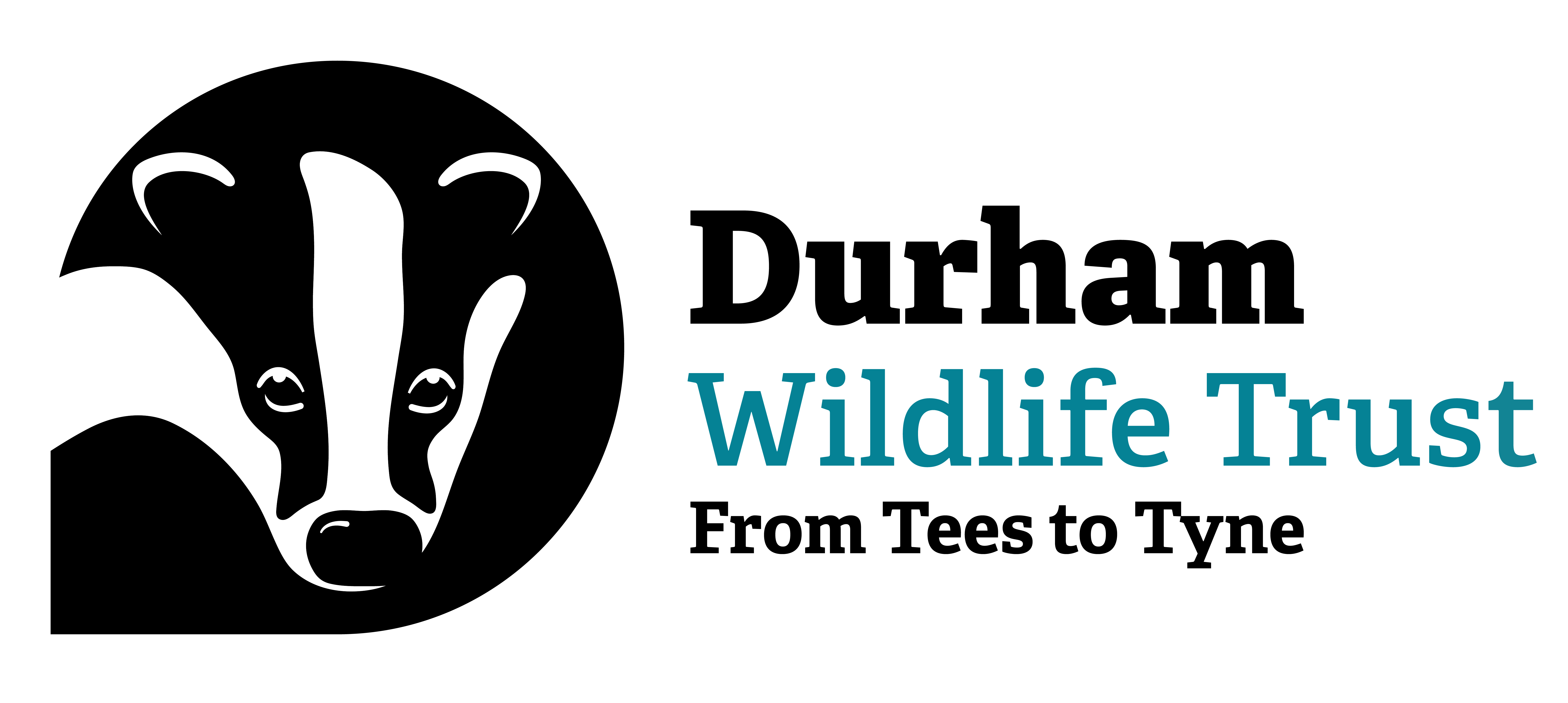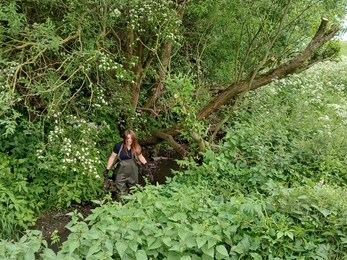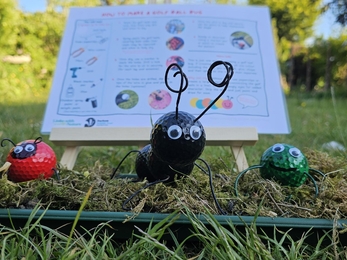Work continues at a pace for the Links with Nature project. Our dedicated conservation trainees enhance our delivery and project capacity. Their contribution enables our volunteer sessions to run each week, delivering improvements at greenspaces in the Coalfields area. Sadly, our first cohort of trainees have completed their training period with us. Emyr and Hayley have been a brilliant addition to our team and we wish them every success for the future. Looking to the future, we are excited to have recently welcomed our new trainees, Jonathan and Mandy, who are already hard at work on tasks and completing training. In this blog, Hayley and Emyr reflect on their time with us, followed by brief introductions from Jonathan and Mandy.
A goodbye and a welcome to Links with Nature trainees
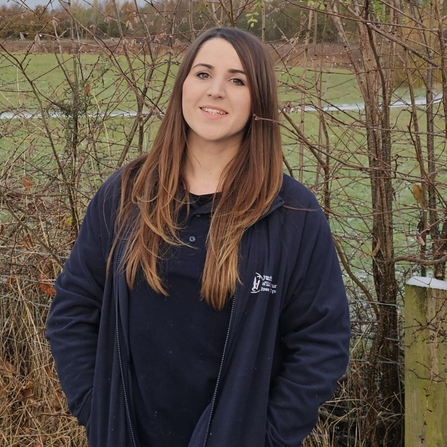
Hayley Cook - Links with Nature Greenspace Officer
Hayley Cook
Well, my conservation traineeship with Links with Nature has come to an end – where has that 9 months gone? The traineeship has been a fantastic experience and has really helped to get a foot in the door of the conservation sector. I’ve gained accredited training, developed my leadership and community engagement skills. I have had the opportunity to gain practical experience across a variety of habitats, learn new tools, techniques, species and address issues facing our greenspaces.
I moved to Houghton-le-Spring in 2020 and was unaware of the various local greenspaces and range of habitats, but this project has allowed me to familiarise with the sites and realise how diverse the Sunderland area is. Some highlight species include European eel, red kite, barn owl, long-eared owl, weasel, stoat, bee orchid, kingfisher, common spotted orchid, and tawny mining bee!
Another highlight was the experience to lead a bird walk as part of our Wonderful Wildlife bioblitz event at Elemore Park. Having never lead a walk previously, this allowed me to step out my comfort zone, share my knowledge with members of the public, and essentially go bird watching! Part of this event included my craft idea of upcycling golf balls found at Elemore Park and using old mattress wire found on our clean ups to create golf bugs, so these materials didn’t go straight to landfill. These have since been used at another event with our engagement officer, Pip, and have been very popular.
An eye-opener during the project has been the clean-up events which helped to deal with anti-social behaviour. Unfortunately, some of the greenspaces are subject to damage from fly tipping, litter, fires and motorbikes/quadbikes. However, since we started the clean ups there has been a significant drop in much of this behaviour, which shows that if the sites are kept in good condition more people care and want to protect them, including reporting the anti-social behaviour.
This traineeship has provided other opportunities and experiences such as charcoal making at Low Barns, butterfly transect surveying, ecology surveying, help with the little tern fencing at Seaton Carew and assisting one of our volunteers on the Wetland Bird Survey at Rainton Meadows.
I look forward to seeing how the project progresses and say thank you for allowing me to be a part of it. It has been a privilege to work alongside great colleagues, volunteers and collaborate with stakeholders, who I hope to continue to work alongside in the future.
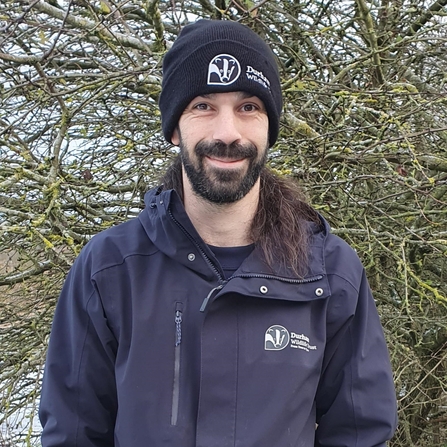
Emyr Hopkins - Conservation Trainee, Links with Nature
Emyr Hopkins
That was fast! It seems like only a few months ago that I was thrust amongst a group of volunteers whose names, by this point, have just about stuck. As much as I have enjoyed and benefitted from the formal training and experience gathered, it is the people involved that have made this traineeship so special. Whether staff or volunteers, all were extremely helpful, and I feel many years wiser from their knowledge and guidance.
From conducting habitat surveys and devising management plans to planning tasks and engaging the community, it would probably be easier to list the things we didn’t touch upon during this traineeship. We have engaged in various tasks both in the maintenance and improvement of habitat within the coalfield area, and also in enhancing access routes for local users.
Community events were a highlight of this traineeship for me; it was great to see locals engaging with the project and using the greenspaces that we have exerted effort to improve. We held several community tree planting events during my time on the Links with Nature project, as well as a Wonderful Wildlife event at Elemore Park, showcasing our project and highlighting some of the species present in the park.
Other highlights included charcoal making, a very interesting process to learn made even better with a late-night barbeque as we shut down the kilns. Probably the most memorable moment was whilst building a hibernaculum at Elemore Park, an enjoyable task in itself. Despite a dissuasion attempt or two by Chris, I felt that our hibernaculum needed at least a barrowload of stones from halfway across the park. I will be hesitant to attempt a similar feat again, although I convince myself that had I not added the stones it would still be playing on my mind.
I also got to spot some remarkable wildlife moments; a kingfisher fishing along Red Burn, a European eel slithering about in Herrington Burn, a large swan mussel at Herrington Country Park and a nesting sparrowhawk at Flint Mill amongst many others.
Since beginning this traineeship, I have gained the confidence and skills to set up a community group to improve my local woodlands. In February I set up Friends of Sacriston Woods and run regular litter picks around the area. I have also worked with Durham County Council woodlands team to set up an official volunteer group that will undertake tasks to maintain and enhance the area.
Due to my efforts with this community group, I have had regular contact with the Parish Council and was co-opted as a member during the annual meeting in May. I have also been successful in my search for continued employment in the sector, beginning a Project Officer role at Springboard once the Traineeship comes to an end. I will look back at this time at the trust with gratitude for the opportunities presented and hope that many more trainees get an opportunity such as this in the future.
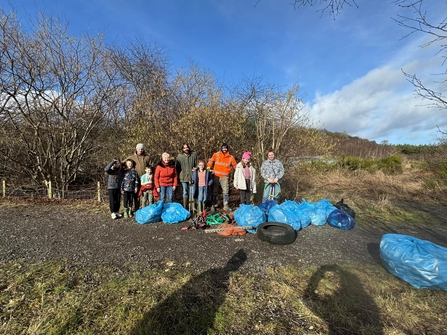
The Friends of Sacriston Woods carrying out a litter pick with Emyr as part of Links with Nature
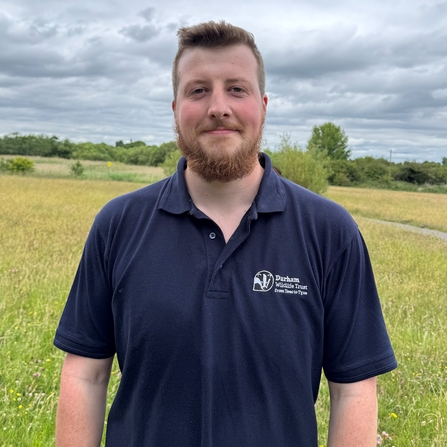
Jonathan Phillips - Links with Nature Conservation Trainee
Jonathan Philips
Hi, I’m Jonathan, and until very recently, (when I took this traineeship, just a few short weeks ago) I was a volunteer with Durham Wildlife Trust. Now, however, I find myself in a position that has not only already begun expanding my education in conservation, but also allowed me to continue the hands-on developing of practical skills that was a big part of why I loved volunteering so much.
Thanks to my previous involvement with Durham Wildlife Trust, and the Links with Nature project in particular, I have had the chance to witness first-hand the significant transformation that has occurred at the sites it oversees. Copt Hill is an excellent example, which is highly convenient as we visited it on my second day as a trainee, conducting a walk over and botany survey. I hold a good deal of nostalgia for the time spent working alongside fellow volunteers to steadily fight back prickly scrub that was attempting to sprawl its way across the slopes of the mound for which the site is named. Even for the experience of trying to dead hedge the remains produced by these battles, though at the time I’m sure it would have seemed a strange thing to ever look back on fondly.
We took these steps in part to improve the site’s general visual appearance, but much more importantly, as a means to protect and rejuvenate the underlying calcareous grassland that was being shaded out and overrun. This kind of grassland ecosystem is not common in this region, and forms a rich, diverse biome for several species. Which brings me back to that botany survey I mentioned previously, a survey that resulted in over seventy species of flora being catalogued!
It is chances like this, to see what real physical positive outcomes we are able to achieve in our local areas, that I am looking forward to as the traineeship goes forward. While also learning the skills needed to enact these changes, be it the safe and proper handling of equipment like chainsaws or brush-cutters, or the planning of tasks and their implementation.
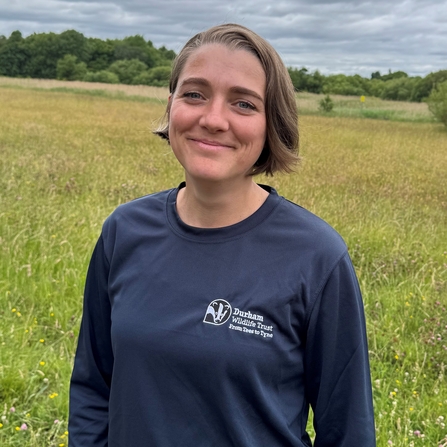
Mandy Walker - Links with Nature Conservation Trainee & part-time Education Leader
Mandy Walker
Having made the leap to follow my heart and change careers I have landed at Durham Wildlife Trust in the Links with Nature team in a place that I feel is part of my roots. As a child, I spent a lot of time around Joe’s Pond, exploring Malton or being told stories of the Seven Sisters. I have always been happier outside, wandering in the woods, bird watching, peering at the mini-beasts at my feet and the bees in my hives.
My journey here started with a casual role in the Education Team, facilitating school visits and running wildlife sessions for children – something I love to do with my own family. Seeing the joy it gives young people and enabling them to connect to the natural world is such a privilege. I have, however, always realised that none of this would be possible without the hard work others had put in to make the reserves the wonderful places they are… and I really wanted to be part of that.
Aware that the job I had being doing for around a decade was not feeding my soul, I rather nervously applied for the traineeship and was thrilled to be accepted. I was worried that my practical experience might be lacking, but as I have already learned in the first couple of weeks in the role, this is why I am here. There are so many amazing colleagues and volunteers who are always keen to share their knowledge.
I couldn’t believe my luck when the first task I went on was a wildflower survey at Copt Hill - in the sunshine with kestrels hovering overhead. Obviously, it isn’t all sunshine and flowers and there is a lot of hard work and a lot to learn! Alongside learning the practical skills needed in conservation, I am really looking forward to improving my species knowledge, especially at local sites, and learning how to undertake work to improve and maintain them so that everyone has the opportunity to connect with nature on their doorstep, just like I did when I was young.
Learn more about Links with Nature
Click the link below to find out more about the project and the ways that you can get involved.
